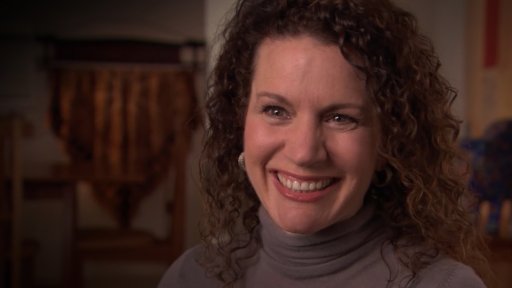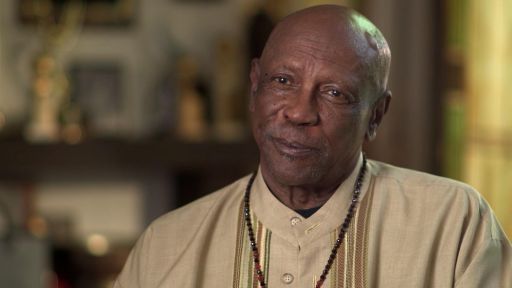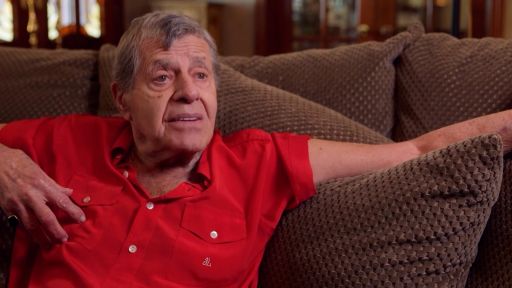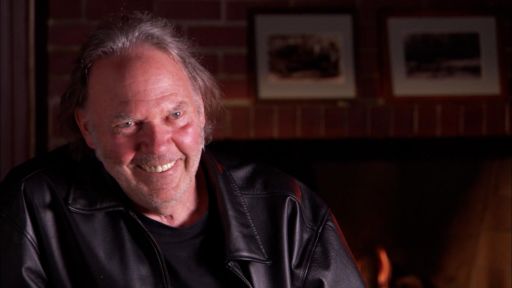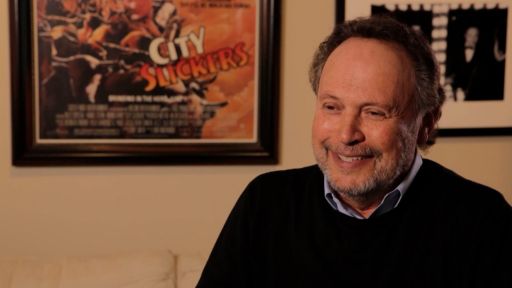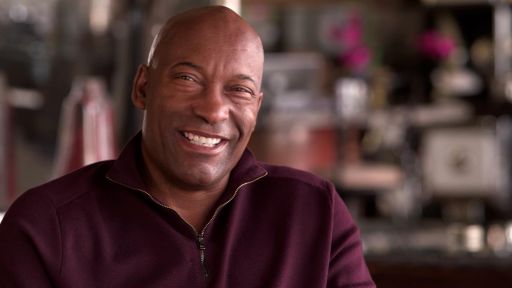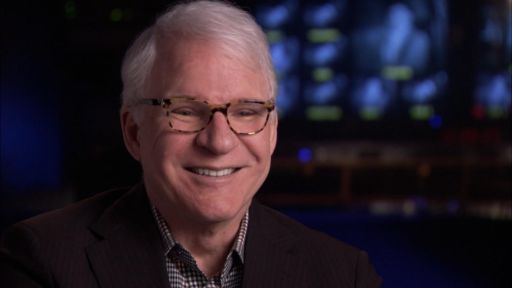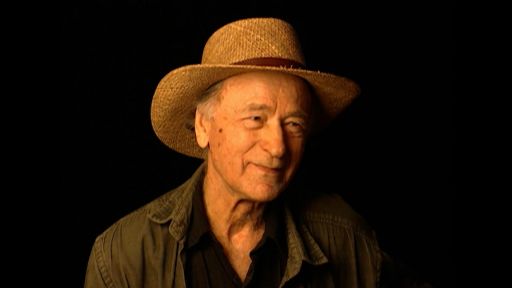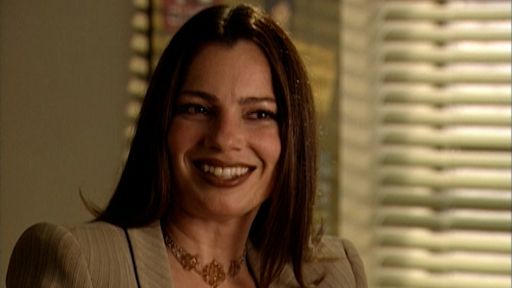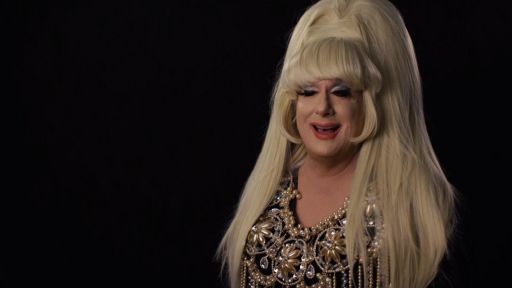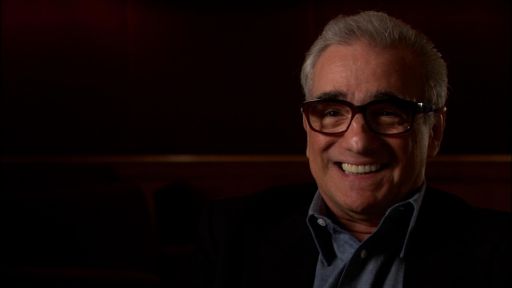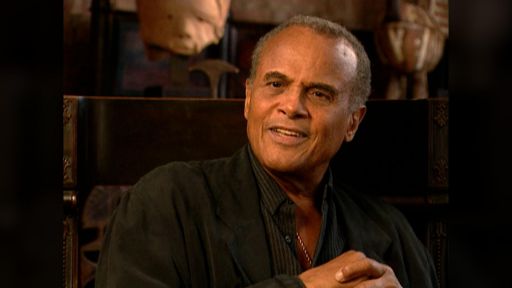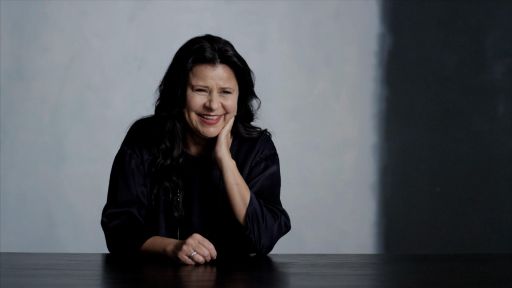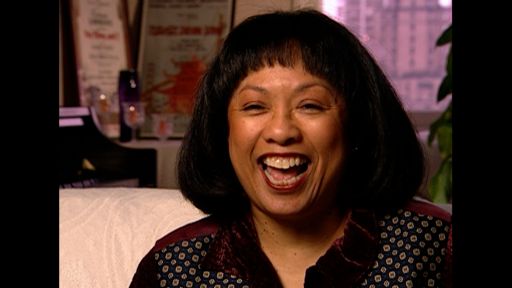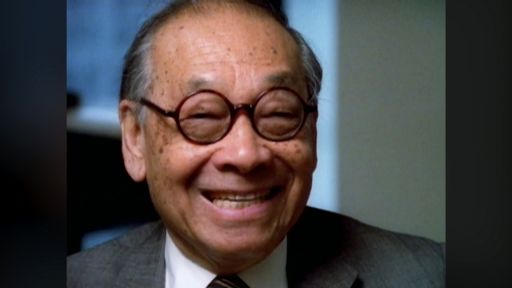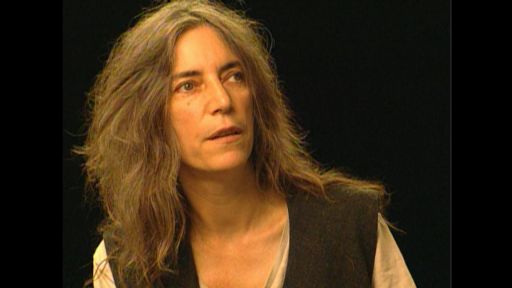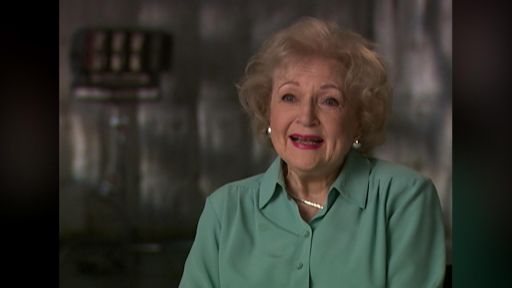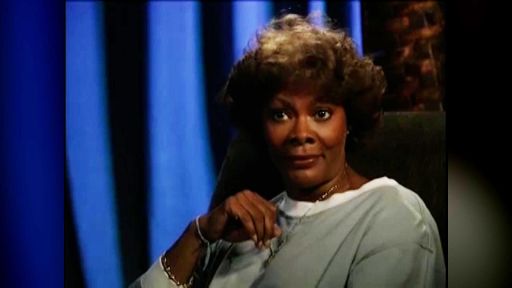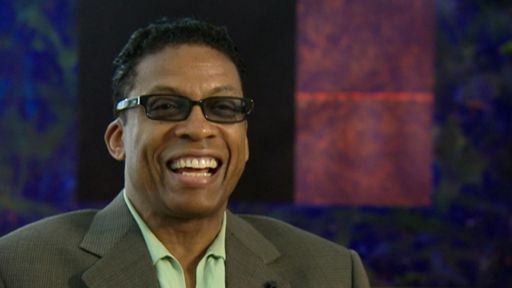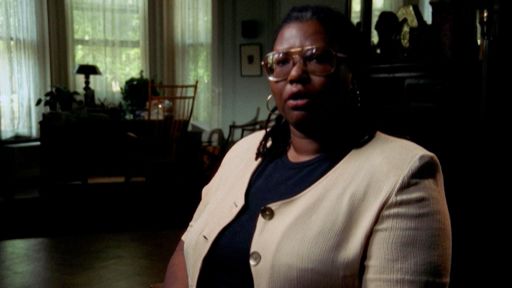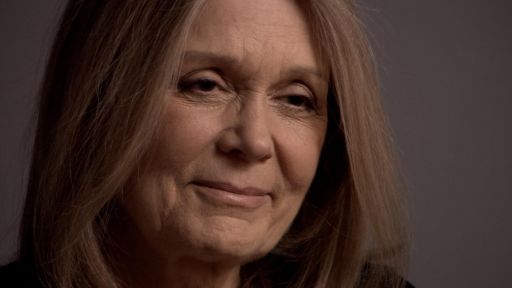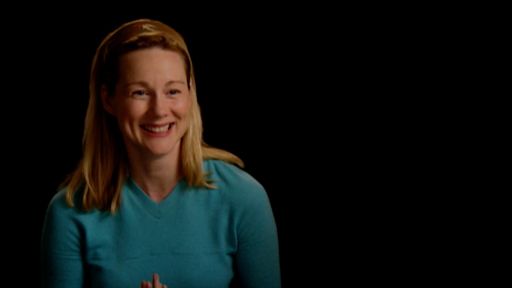TRANSCRIPT
- [Interviewer] Now, did you have to audition for West Side Story?
- I certainly had to audition for West Side Story.
I auditioned everything.
I auditioned singing, I did a singing audition.
Then I did a reading, an audition with a scene which was the scene of the candy store, which is the scene that was being used for Anita.
And then after I auditioned in person, then we also did a screen test not of the singing part, but of the acting part.
And I can tell you that every dark eyed girl with dark hair, in Hollywood and Pasadena, and God knows where else, was auditioned and screen tested for this.
It was a long haul.
And my almost bete noir was the dance part, because I had never danced that way before, ever.
I was a Spanish dancer.
That's what I did, I did flamenco and I played castanets very well.
But I did, I really didn't know from that kind of dancing ever.
And after my two auditions, the singing and the acting, they were very happy.
When I say they, I mean Jerome Robbins and Robert Wise, who was co-directing.
At that point, Jerry said I really like what you're doing.
I would like for you to play Anita.
But he said, you really have to audition for the dance part because if you can't cut that, there's no way that I can use you.
And I gulped really hard.
It's quite an interesting story.
I said, how long do I have, before the audition?
He said you really have quite a while, because he said we've got so much to do.
Because they were also doing film tests of effects, all kinds of stuff in advance of the actual filming.
And he said, we have lots more people to see.
But he said, I really, I really, I'm favoring you, but you must audition.
What I didn't tell him is that I hadn't danced since I was 17.
I was then, I guess about 25 or something like that, 24, 25.
I hadn't danced, not one lick since I was 17, which was a film with Mario Lanza, called The Toast of New Orleans.
And I ran to the local dancing school.
It was the Eugene Loring.
Eugene Loring was a choreographer dance school.
And I registered for every dance class that I could.
And I really did, I worked my butt off.
I went to ballet, I went to, and I was never a ballet dancer.
I went to ballet, I went to jazz, I was finally introduced to jazz.
I went to every dance class that I could possibly go to which meant that I was working from nine in the morning probably 'till about six or seven in the evening, after not having dance forever and ever and ever.
And never having danced that kind of dance in my life.
I worked so hard that one teacher said to me one day after class, it was about seven in the evening, she said I do not want you to come back to my class again.
And I said, oh, why?
I was so upset.
And she said, because dear you turn a funny shade of purple.
You work so hard, you turn a funny shade of purple.
And I'm afraid something's gonna happen to you, and I don't want it to happen in my class.
And it had never occurred to me, and it was true.
I went to the ladies room that evening, I remember, to look at the shade of purple that I was, and indeed, I was the color of an eggplant.
I was so overheated.
And I remember too, that I worked so hard that I would raise a fever.
And I knew that it was a fever because I was extremely hot and had huge goosebumps at the same time, which is what happens when you have a fever.
And I think the only thing that kept me from just dropping dead was just my, I'm very strong, I have enormous stamina.
And my youth, although I was really older than all the other dancers eventually who were in the film.
Well, that's what I kept doing.
I kept doing that for about a month and a half.
And I was finally called after a month and a half and said we're going to do your audition next, I don't know, it was like two weeks from then.
And you have to be at the studio at 2:00 PM, blah, blah.
And Howard Jeffries, Jerome Robinson's assistant, will audition you.
I knew I wasn't ready, as hard as, it was like asking someone to play eight sets of tennis a day for a month.
You still don't become a tennis player.
I called a girlfriend named Deborah who had played Anita on the road.
And I said help me, what can you do to help me?
I know I'm not really ready.
And she very generously said, well I can teach you a couple of sections from, a section from America and a section from the dance at the gym, the mambo, 'cause she said I'm sure they'll audition you for both those things.
And she said, but I can't guarantee that the section that I teach you is gonna be the one that they will be showing you in the audition.
And I said, I don't care, just teach me something.
And she did.
And I went to the audition with my heart in my throat, because who knew?
So Howard Jeffries takes me by the hand.
He says, okay Rita, let me teach you a section of America.
And I said, okay.
(Rita gulps) And, he taught me the one that Deborah had taught me.
You wanna talk about, what is that kismet?
And as most people know, when you do a dance audition you get taught the dance.
And then, you get taught it very slowly and then you do it a little faster, a little faster.
And then eventually within 15 minutes or so you have to do it back at the choreographer, but with style and at speed.
(fingers snap) And I got through that.
And then he said, now let's do the mambo at the gym.
And I thought, oh.
And, it was the ones that Deborah taught me.
And I did it.
And then went home.
And I was just dying, because I knew I was far from perfect.
I found out later, this is the story I was told, that Jerry very anxiously called Howard Jeffries and said so what happened, can she do it?
And according to what I heard, Howard said I think she hasn't danced in a while.
But he said, she really is, he said I think she can do it, I think we can beat it out of her.
He said, but you know what's amazing?
She learns so fast.
Well, that was cheating but hey, I got the Oscar.
The rehearsals on West Side story took months, I seem to recall months.
It was still a time when actually it was, that was probably the last film where you could get away with that kind of long schedule.
I remember that we had gotten a guarantee that we would be on the film for, oh gosh, six weeks.
And I think we were on the film for about six months.
We all earned money and we were thrilled about it.
That's Jerry, Jerry can't, Jerry was unable to say print it, for a very simple reason, given the kind of person he was.
Once you said print it, the imperfection of something was there forever on record.
Now, I think what Jerry didn't seem to understand is that when you have more than one person in a scene, in a dance scene let's say, you have a group of people, everyone is not going to be perfect.
It's simply not possible, the odds are that somebody will always do something not necessarily wrong, but just not as perfect as he would like them to be.
So he would do it over and over and over, which is what eventually got him fired from the film.
To our great distress and heartbreak, we were just heartbroken about that.
But the rehearsals took weeks and weeks and weeks.
I mean, I think America took what?
I think a couple of weeks to shoot, just a very, very long time.
I may be exaggerating, but it's not intentional.
It certainly seemed like it, it was long.
We shot from every conceivable angle.
We shot it and not only that, when he wanted to change angles, then you had to do it again over and over and over and over.
And that's what took so long.
- [Interviewer] Now Bernstein's music was brilliant, but it wasn't necessarily easy moves for dancers.
Is that right?
Can you tell me about that?
- Bernstein's music was extremely difficult.
It was all about meter, the meter is so strange.
It really isn't strange if you can read music or you can play an instrument, but everything about it was complicated.
The the verse to America ♪ Puerto Rico, you love the island ♪ is, I've never seen anyone be able to sing it properly unless they rehearse and rehearse and rehearse.
Because there's so many competing rhythms in the back of it.
There's the clave.
(tongue clicking) And then you've got something completely different, it's going (whooshing).
And if you're learning this song, you say well where am I singing?
Am I singing with the shukka shukka, or am I singing with the clave?
And what you find out is that no, you're not.
What you're singing is three quarter time.
It took me the longest time to understand this.
♪ Puerto Rico, you lovely island ♪ That's one, two, three, two, two, three, three, two, thee.
And I remember doing this number with a very famous person, who obviously is gonna remain nameless, who sings.
And we were doing it for a benefit.
And she just could not get that.
Well, it's difficult.
It's not as though she was, didn't know anything about music, it's very difficult to do.
- [Interviewer] Tell me about the production.
What was unusual about West Side Story for its time?
- I think that one of the things that was unusual about West Side Story, for its time, is the kind of dancing that we did in that film.
I don't think that kind of dancing had ever been seen on film before.
Ever, ever, ever.
Because it was essentially, from my standpoint as an actor, was character dancing.
I don't think that I did any step as Anita that he would've given to anyone else in that cast.
Anita had her steps, and Bernardo has his steps.
The Jets danced in a certain way, the Sharks danced in a very specific way.
It was real character stuff and that was just extraordinary.
There were many things about the film that were extraordinary, because they were simply doing in some ways what the play had done.
The costumes weren't gorgeous.
Whoever heard of a musical where there weren't spangles and shiny things on costumes?
Nothing even remotely like that, the colors were strange.
They were mustard colors and aubergine colors.
That was a Irene Sharaff, and rust colors and purple.
I mean, when you think of the extraordinary suit that George Chakiris wore to the mambo at the gym, which became a huge fashion after the film came out, the purple shirt and that slender, gorgeous black silk jacket and pants.
It, the whole look of it was so different, so unique.
And who ever heard of a hit movie with people who sang in an operatic kind of style?
You know what we call legit style, soprano stuff.
Whoever heard of that?
And you know, how did we get away with it?
It's just, it was unique in every respect.
I know that some people from theater were disappointed in the film.
They didn't think it lived up to the play.
And, I have nothing to say about that.
But as a film, on its own, it was like nothing else that had ever happened to the screen.
And you know what?
Nothing else like it has ever happened on the screen.
- [Interviewer] The movement that you talked about before that you hadn't done it, it just looks jazzy, but it actually requires a certain degree of ballet technique, wouldn't you say?
- The kind of dancing we did required an enormous amount of ballet technique.
And in fact, during rehearsals, our warmup consisted of a ballet warmup, which I, well I'd done it when I was a kid and I studied ballet but that was a long time ago.
Or as they would say in England, donkeys years ago.
So I became, you know, really I was the outsider.
I was the outsider in every respect.
All of these kids were just trained to dance.
I didn't have that frame of reference.
I didn't even know about that kind of discipline.
It turns out that I'm just a very, very hard worker.
And Jerry would, which amazed me, would compliment me now and then, which I can't tell you how unusual that was in the atmosphere of this particular film.
Jerry one time actually showed me a photo of myself with the other dancers, in our ballet warmup.
We were doing the jumps in the air, like this, and I can't remember the ballet term for it 'cause I'm really not a ballet dancer.
And I was the only one whose toes were pointed in fifth position.
And he said, look at that.
He said you!
This was meant to be a compliment.
You're the only one who has your feet pointed in the air.
So now and then he would say some really great things to me, but he was very, very tough on me.
- [Interviewer] It seems like everybody really wanted to please him.
Why?
- Everybody wanted to please the authoritative, unforgiving daddy.
When you're young, and dancers are young for their years even when they're older, you're always looking for that kind of approval.
And he doled it out in little, you know, I used to think that he doled it out, he had a little tiny paper bag with good for yous in them.
You know?
So that was my image.
A little bitty paper bag and a tweezer.
And he'd go, there you are.
It's all psychological.
Dancers are very insecure people.
I mean, there's a Baryshnikov here and there and there's a Nureyev here and there, but they're not, there aren't many of those.
And they become, there's always a very strange symbiotic relationship between, I shouldn't say always, but very often, a symbiotic relationship between dancers and their masters.
And that's really the nature of that kind of relationship.
There've been, I know that Michael Bennett was known as a rather severe task master.
And a lot of choreographers have that relationship with their children, I don't know how else to put it.
- [Interviewer] I understand Jerry was there for about 60% or so of the shooting.
And one of the numbers he, well let me ask you, was he there for Cool?
- Jerry was definitely there for the number Cool.
It's my favorite number in the film.
I think it's an extraordinary number in many respects.
One, it's a real character driven number.
It is one of the most intense dance numbers I've ever seen on the screen in my life.
I love Moulin Rouge, and I love Chicago but I've never seen anything like this in my life.
I was there to just to watch it, for the entire, well I was, I watched a lot of the shoot, things that I wasn't in, because I just enjoyed it so much, it was so thrilling.
I've never seen dancers work so hard in my life, as they did in Cool.
You may recall that the ceiling of the, they were in a garage, but the garage is very low.
And we were shooting this in summer and it was hot as hell.
And those kids were just suffering something awful.
And they did it again over and over and over.
And then they would change angles.
And they'd go through that thing again, over and over and over.
It was, he had those kids in a frenzy, in a controlled kind of frenzy like this.
And it shows, and it's supposed to be very frightening because now somebody's dead and they're responsible for the death of this young man.
And you can just, it's palpable in that scene.
And that's good old Jerry, scaring the hell out of everybody and working them to death.
And I love him, I just I love him.
When I think of the things he did, what an amazing man.
- [Interviewer] And of course he was there for the prologue.
- Oh yeah.
- You weren't?
- Oh you wanna hear a funny story about the prologue?
It's silly, to show you how crazy he was.
There's a wonderful story of something that happened during the shooting of the prologue in New York City, which by the way, all of those areas were really what is now Lincoln Center.
And at one point the dancers, as all dancers between takes, they're very mischievous, they're rowdy.
And it was also a release, because everything was so intense.
They started to do a rain dance, and they had been plagued by rain anyway.
And by God it started to rain and Jerry got angry at them.
(Rita laughing) He got angry at them, because it was their fault, the rain dance brought on the rain.
He just got insanely unreasonable.
Isn't that marvelous?
He was nuts.
- [Interviewer] To what do you attribute the film's lasting success?
- I think the film's lasting success really is, should not be surprising.
It was unique, not only for its time, it continues to be unique.
The language is somewhat dated, but in fact now it's become a kind of a wonderful old treasure.
You know, people are saying I'm hep and that sort of thing, but it's just like a jewel.
It's different from any other movie ever made at any time.
I talk to young people who've seen it for the first time, who are just absolutely overwhelmed.
Despite the language, which is you know so dated.
But, they're astonished.
They're absolutely, I get real admiration from young people, who have seen the film recently, because they're just so impressed.
And that, I think it's here to stay forever.
It's one of the great classics.

